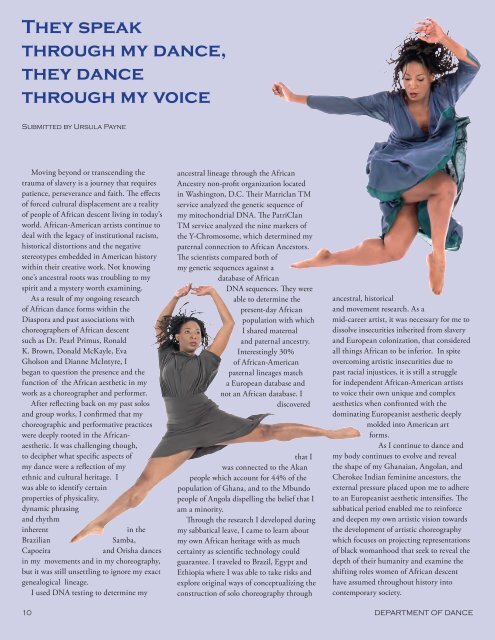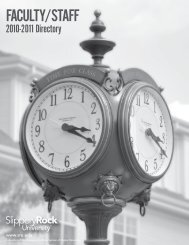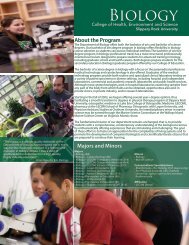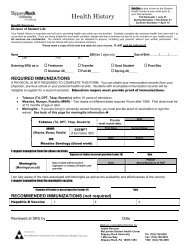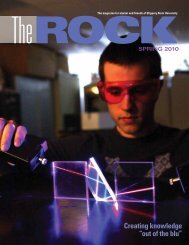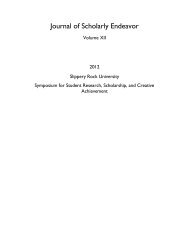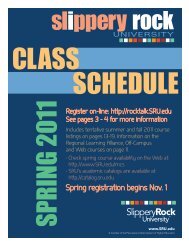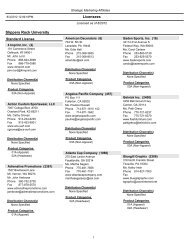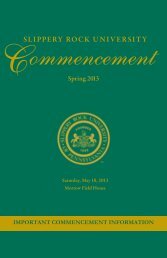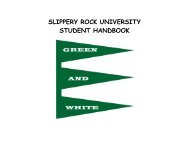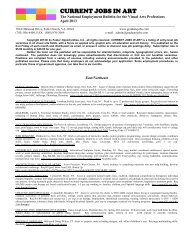2006 Dance Newsletter - Slippery Rock University
2006 Dance Newsletter - Slippery Rock University
2006 Dance Newsletter - Slippery Rock University
You also want an ePaper? Increase the reach of your titles
YUMPU automatically turns print PDFs into web optimized ePapers that Google loves.
They speak<br />
through my dance,<br />
they dance<br />
through my voice<br />
Submitted by Ursula Payne<br />
Moving beyond or transcending the<br />
trauma of slavery is a journey that requires<br />
patience, perseverance and faith. The effects<br />
of forced cultural displacement are a reality<br />
of people of African descent living in today’s<br />
world. African-American artists continue to<br />
deal with the legacy of institutional racism,<br />
historical distortions and the negative<br />
stereotypes embedded in American history<br />
within their creative work. Not knowing<br />
one’s ancestral roots was troubling to my<br />
spirit and a mystery worth examining.<br />
As a result of my ongoing research<br />
of African dance forms within the<br />
Diaspora and past associations with<br />
choreographers of African descent<br />
such as Dr. Pearl Primus, Ronald<br />
K. Brown, Donald McKayle, Eva<br />
Gholson and Dianne McIntyre, I<br />
began to question the presence and the<br />
function of the African aesthetic in my<br />
work as a choreographer and performer.<br />
After reflecting back on my past solos<br />
and group works, I confirmed that my<br />
choreographic and performative practices<br />
were deeply rooted in the Africanaesthetic.<br />
It was challenging though,<br />
to decipher what specific aspects of<br />
my dance were a reflection of my<br />
ethnic and cultural heritage. I<br />
was able to identify certain<br />
properties of physicality,<br />
dynamic phrasing<br />
and rhythm<br />
inherent<br />
in the<br />
Brazilian<br />
Samba,<br />
Capoeira<br />
and Orisha dances<br />
in my movements and in my choreography,<br />
but it was still unsettling to ignore my exact<br />
genealogical lineage.<br />
I used DNA testing to determine my<br />
ancestral lineage through the African<br />
Ancestry non-profit organization located<br />
in Washington, D.C. Their Matriclan TM<br />
service analyzed the genetic sequence of<br />
my mitochondrial DNA. The PatriClan<br />
TM service analyzed the nine markers of<br />
the Y-Chromosome, which determined my<br />
paternal connection to African Ancestors.<br />
The scientists compared both of<br />
my genetic sequences against a<br />
database of African<br />
DNA sequences. They were<br />
able to determine the<br />
present-day African<br />
population with which<br />
I shared maternal<br />
and paternal ancestry.<br />
Interestingly 30%<br />
of African-American<br />
paternal lineages match<br />
a European database and<br />
not an African database. I<br />
discovered<br />
that I<br />
was connected to the Akan<br />
people which account for 44% of the<br />
population of Ghana, and to the Mbundo<br />
people of Angola dispelling the belief that I<br />
am a minority.<br />
Through the research I developed during<br />
my sabbatical leave, I came to learn about<br />
my own African heritage with as much<br />
certainty as scientific technology could<br />
guarantee. I traveled to Brazil, Egypt and<br />
Ethiopia where I was able to take risks and<br />
explore original ways of conceptualizing the<br />
construction of solo choreography through<br />
ancestral, historical<br />
and movement research. As a<br />
mid-career artist, it was necessary for me to<br />
dissolve insecurities inherited from slavery<br />
and European colonization, that considered<br />
all things African to be inferior. In spite<br />
overcoming artistic insecurities due to<br />
past racial injustices, it is still a struggle<br />
for independent African-American artists<br />
to voice their own unique and complex<br />
aesthetics when confronted with the<br />
dominating Europeanist aesthetic deeply<br />
molded into American art<br />
forms.<br />
As I continue to dance and<br />
my body continues to evolve and reveal<br />
the shape of my Ghanaian, Angolan, and<br />
Cherokee Indian feminine ancestors, the<br />
external pressure placed upon me to adhere<br />
to an Europeanist aesthetic intensifies. The<br />
sabbatical period enabled me to reinforce<br />
and deepen my own artistic vision towards<br />
the development of artistic choreography<br />
which focuses on projecting representations<br />
of black womanhood that seek to reveal the<br />
depth of their humanity and examine the<br />
shifting roles women of African descent<br />
have assumed throughout history into<br />
contemporary society.<br />
10 DEPARTMENT OF <strong>Dance</strong>


